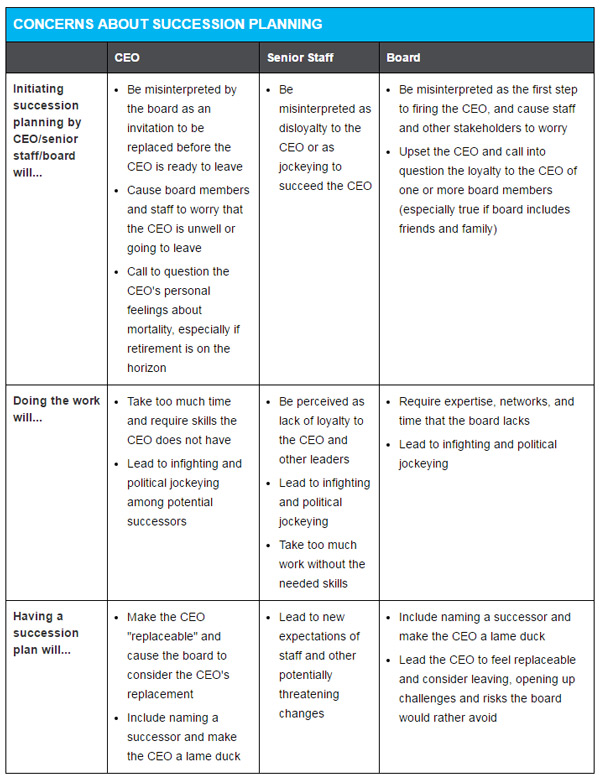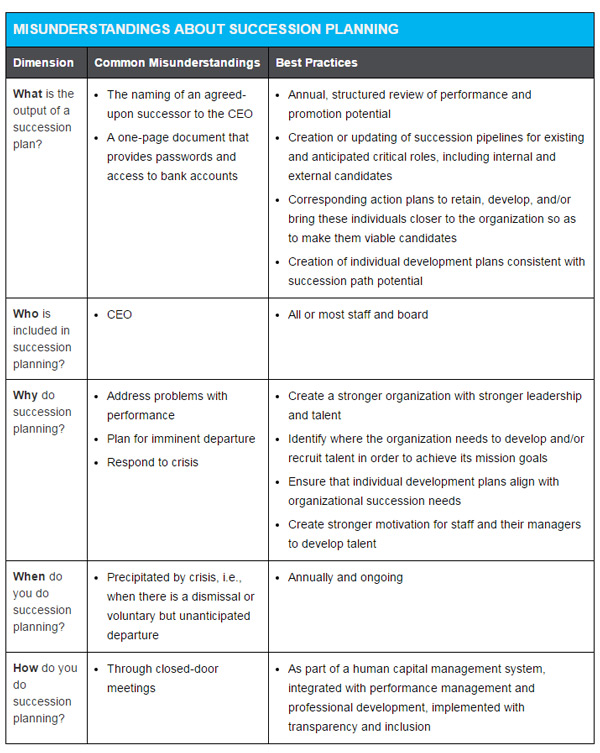Everyone agrees that succession planning is one of the CEO's and board's most critical responsibilities. In fact, a recent Bridgespan article highlighted it as by far the No. 1 organizational concern for US nonprofits. Yet all the studies suggest that nonprofits and their boards grossly neglect this all-important task. What is the disconnect?
In our experience at AchieveMission, many nonprofit leaders avoid succession planning because of the anxiety and painful misunderstandings they fear it will create. And, this high emotional charge rests, in turn, on prevalent misunderstandings about succession planning.
If your organization needs a new or stronger succession plan, the key to success is to acknowledge the anxieties that you and other stakeholders may have and reframe your understanding of succession planning. Tackling these hidden obstacles will create the conditions for you to reduce anxiety, smoothly move your succession planning forward, and produce a palpably stronger organization.
Acknowledge Others' (and Your Own) Anxieties
While many of the anticipated fears associated with succession planning may be unfounded, the feelings are very real. Whether you are the CEO or a board or staff member, it is essential to patiently listen for and validate these concerns before trying to move forward. Here are some typical examples.

As you acknowledge your own and others' concerns, identify the assumptions that drive them. You may find that many of these are based on misunderstandings about succession planning, and that a reframing of what it is all about will help quell these anxieties and enable you to make progress.
Reframe Succession Planning to Address Concerns
Anticipating and reframing the key dimensions of strategic succession planning will shift emotional reactions and align the team.

With best practices in mind, you are in a position to anticipate and respond to questions and concerns about succession planning. Create space for skepticism (Are you being honest with us?) and rumors (Is the board unhappy with the CEO?) to be voiced and addressed. Be forthright about the challenges you will need to face, e.g., learning how to conduct succession planning sessions and write development plans, while reassuring the team that, with practice, the process saves time and provides benefits that will accrue to them, the organization, and its mission.
The Succession Planning Conversation Agenda
Here's a practical script that integrates the two sections above. It's applicable with some modification to use by any of three roles: staff, CEO, and board.
- Express enthusiasm for succession planning, tempered with acknowledgment of possible concerns and misunderstandings.
- Invite questions and concerns. Just acknowledge and note at this point. Use the "Concerns About Succession Planning" table above to probe, especially if people are reluctant to share.
- Discuss definitions of and prior experiences with succession planning in other organizations. Use the Common Misunderstandings column in the "Misunderstandings About Succession Planning" table above to probe, especially if people are reluctant to share.
- Ask team members to work back from their prior experiences and assumptions to their questions and concerns about succession planning.
- Suggest that an alternative concept of succession planning is possible and ask: "What will happen if your understanding changes?"
- Explain the new succession planning process using the "Misunderstandings" table:
- What
- Who
- Why (benefits)
- When
- How
- Discuss
- Align and move forward
Thank you to the many AchieveMission consulting clients, as well as AchieveMission Partner Mike Markovits and Mikaela Seligman, AchieveMission senior consultant, for their insights and support for this article.
AchieveMission is proud to collaborate with Bridgespan on topics related to leadership development and human capital management. Please also see Human Capital Management: Don't Reinvent the Wheel, Measuring the ROI of Human Capital Management, and How to Recognize—and Fix—Human Capital Management Issues.


